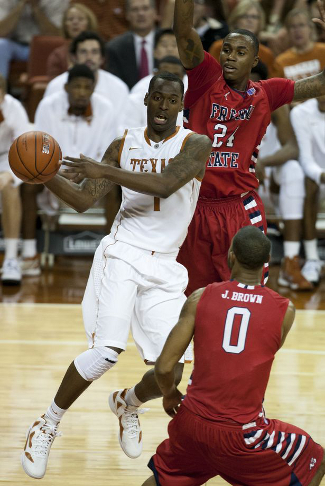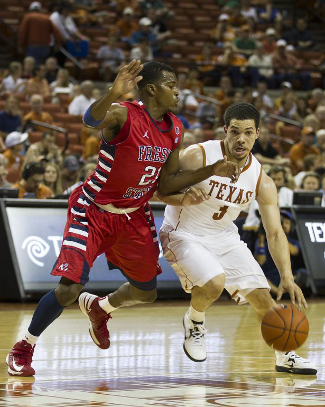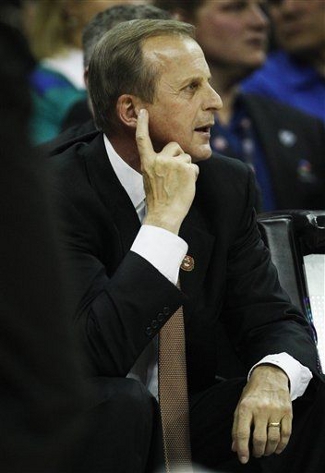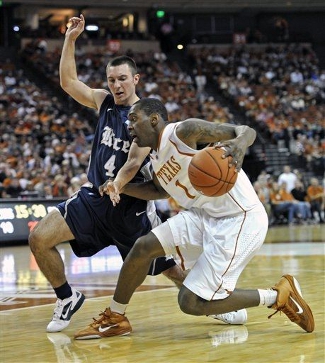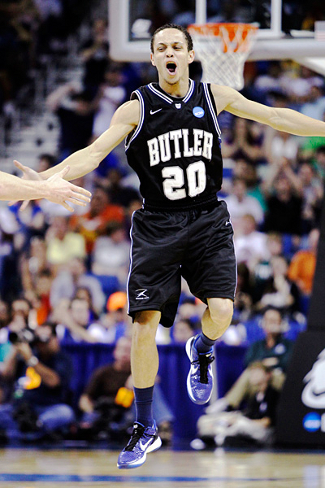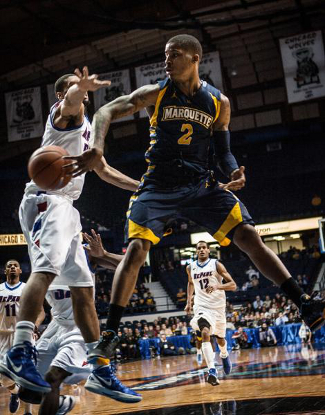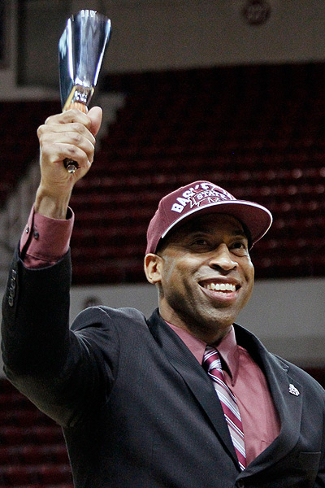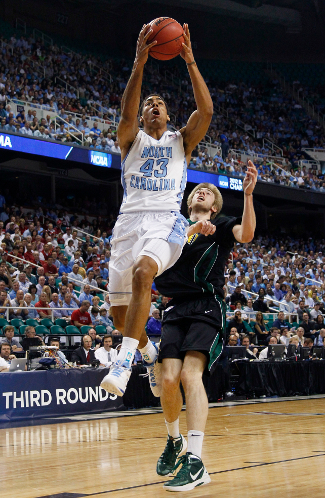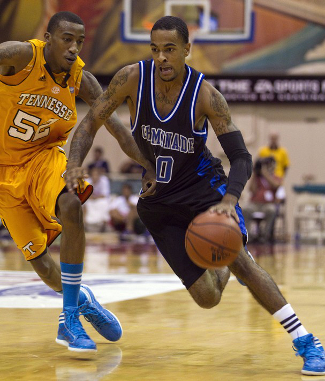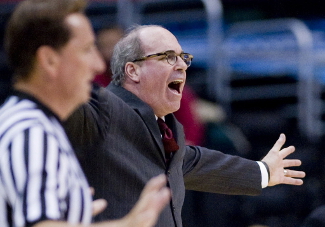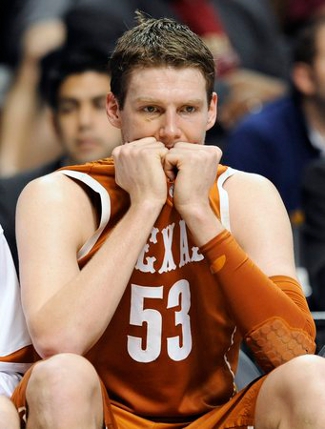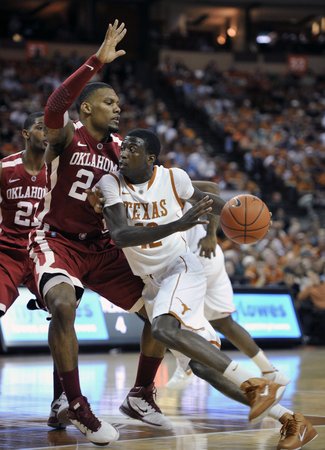In the first 14 years of the Rick Barnes era, the Longhorns lost just two home openers. In fact, in the last ten years, no team had started their season with a road win at the Frank Erwin Center. Friday night, a Texas squad with no scholarship upperclassmen came perilously close to ending that streak and suffering an embarrassing upset at the hands of Fresno State.
Sheldon McClellan carried Texas to the win Texas never led the visiting Bulldogs by more than five points, and did not take the edge for good until less than two minutes left in the game. Poor shooting and a rash of first-half turnovers rendered the Longhorn offense ineffective, making things interesting down to the final second. Fresno State’s desperation heave from the backcourt missed the mark at the buzzer, allowing the Longhorns to survive with a 55-53 opening night victory. Sophomore Sheldon McClellan led the way for Texas, putting in 20 points — 18 of them in the second half — to carry his team to victory. Expectations were high for McClellan coming into the season, as fans and pundits both looked for the gifted scorer to have a breakout season. With Myck Kabongo sidelined during an NCAA investigation and Jaylen Bond suffering from an ankle injury, it was even more necessary that McClellan live up to those expectations against Fresno State. For the first twenty minutes, it didn’t look like the sophomore was going to do so. He missed a trio of three-pointers to start the game, and didn’t even crack the scoresheet until notching a pair of free throws with 5:25 to go in the first half. Another missed three-pointer and a missed layup rounded out McClellan’s first twenty minutes, as he and the Longhorns headed to the locker room in a 25-all tie. The poor start didn’t deter McClellan, as he turned up the aggressiveness in the second half. With Texas running staggered baseline screens to free him up, the sophomore repeatedly received the ball on the wing and immediately took it at the defense. Driving baseline and slashing to the lane, he put the Bulldogs on their heels and earned trip after trip to the line. McClellan finished the game with a perfect 14-of-14 mark at the charity stripe, grinding out the points to push Texas into the win column. While Sheldon was struggling in the first half, freshman point guard Javan Felix was making an early splash. The New Orleans native scored six of Texas’ first eight points, showing off his soft touch on runners in the lane before pulling up for a jumper from the elbow. The hot start was short-lived, though, as Felix quickly tailed off and finished the game just 5-of-15 from the field. He lost his touch on the floater, and the Fresno State defense was able to challenge and sometimes even block that free-throw line jumper.
Javan Felix scored right out of the gate Although Felix only finished with one assist on the night, he set up his teammates numerous times with nice feeds into the post and kickouts for wide-open threes. Unfortunately, the Longhorns simply couldn’t knock anything down and wasted some great opportunities. On many possessions, Texas was fouled down low and had to earn their points from the line, something that doesn’t show up when looking in the assist column. Although Texas had just three assists on eighteen made buckets, the team posted a solid free-throw rate of 49%, essentially earning one free throw for every two field goal attempts. Though Felix was the one who turned heads on Friday night, the freshman who entered the game with all of the hype was McDonald’s All-American Cameron Ridley. His defensive performance was promising, as he stood tall in the paint, didn’t bite on fakes, and challenged the Fresno State bigs. Despite being limited to just 13 minutes, Ridley logged three blocks and owned the paint with the steady resolve of recent Longhorn standout Tristan Thompson. As encouraging as Ridley’s performance was on the defensive end, his struggles on the other end of the court kept him on the bench down the stretch. The 6’9″ big man was called for a pair of offensive fouls, had trouble handling post feeds, and was very slow to react to double teams from the Bulldog defenders. His one offensive highlight came on Felix’s lone assist, when the point guard spun in the lane before dumping a jump pass to Ridley on the baseline. Cameron took one powerful step and flushed it home for an and-one opportunity, but missed the ensuing free throw. The Longhorns were led on the boards by sophomore Jonathan Holmes, who consistently crashed the glass from the wings and high post. He snagged 14 rebounds, including eight on the offensive end, making up for the huge hole left by Bond’s injury. While Jonathan didn’t have much success scoring inside, his ability to extend possessions was key on a night that Texas had trouble putting the ball in the hoop. Texas’ 44.1% mark on the offensive glass kept possessions alive, but it was the Longhorn defense that kept Fresno State within reach. Texas opened both halves in a 2-3 zone that surprised the Bulldogs and led to long possessions with questionable shot selection. However, the second-teamers let the Fresno State guards find cracks to exploit with dribble penetration, leading to some easy buckets in the first half. For the game, Texas limited Fresno State to just .914 points per possession. Getting that many freshmen to buy into a defense-first concept is certainly a big deal, but exuberance should be tempered by looking back at the FSU offense from a year ago. The Bulldogs were in the bottom half of D-I hoops according to Ken Pomeroy, whose adjusted offensive efficiency rating gave them just .989 points per possession. Their effective field-goal percentage was one of the 100 worst in Division I, checking in at only 46%. Texas’ defensive performance was definitely stout on Friday night, but fans should limit their excitement until after the Horns face tougher competition in the second and third days of the Maui Invitational. While the bad shooting was certainly a big culprit, the Longhorns also had issues running their sets early in this one. The Longhorns worked hard in the first half to get their scorers open with baseline screens, but the Texas bigs repeatedly allowed the sets to get too stretched out. On different possessions, Holmes, Connor Lammert, and Ioannis Papapetrou all found themselves holding the ball four or five feet beyond the perimeter, hoping to make an entry pass against tight Fresno ball pressure. Even with perfect execution on the baseline, that feed would have been far too difficult and dangerous to make. The Longhorns also struggled to make any long jumpers, hitting just one of their 13 three-point attempts. The numbers aren’t worth panicking over after just one game, but outside shooting could prove to once again be a major issue for Texas this season. Last year’s squad held the ignominious distinction of being the school’s worst three-point shooting team (32.78%) in the last 13 years, and the Horns lost the top two shooters from that team in J’Covan Brown and Sterling Gibbs. Their departures leave Coach Barnes with five rotation guys who combined for a hideous 30.7% mark from long range in 2011-12. If this young Texas team actually challenges last year’s marks for three-point futility, the Horns are going to struggle to score against a ton of packed-in defenses. Up next: vs. Coppin State (0-1); Monday, 7 P.M. CT |








